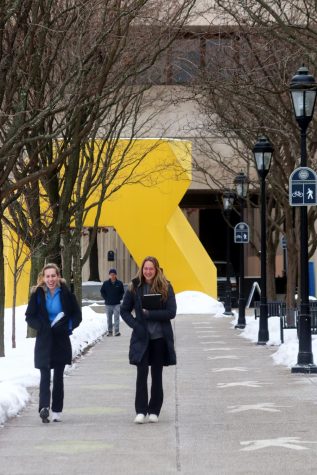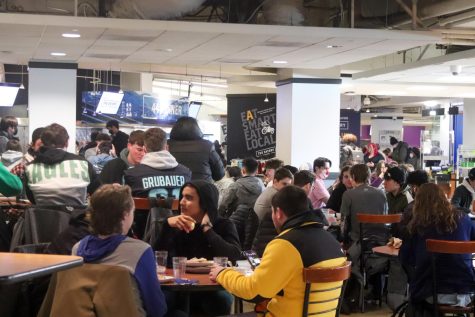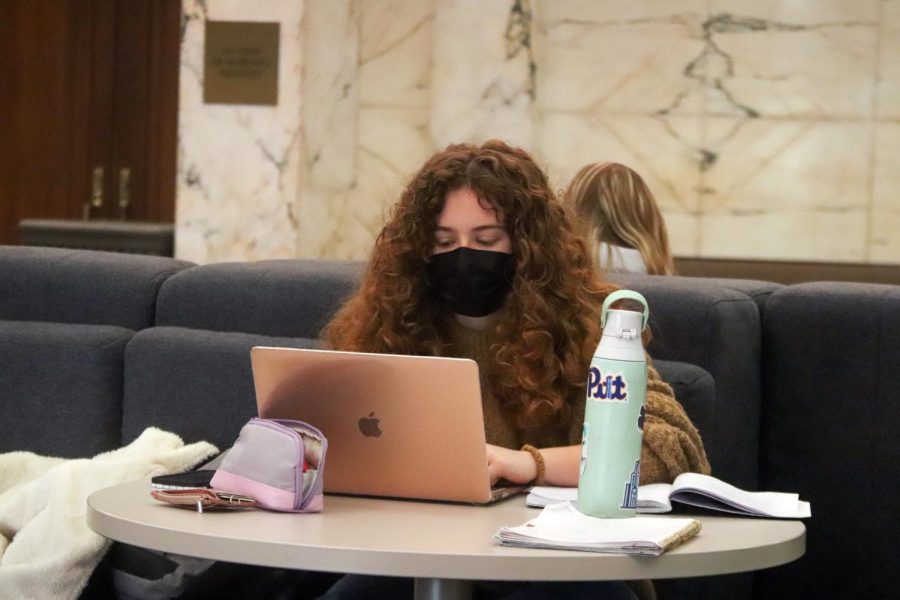Students nervous, excited as Pitt starts in-person classes
Patrick Cavanagh | Senior Staff Photographer
Robin Higgins studies in the William Pitt Union on Thursday afternoon.
January 28, 2022
For Noah Kenton, a junior information science major, the return of in-person classes could not have come soon enough — and in fact, it should have come sooner.
“There’s definitely a huge difference in terms of quality, like pacing, the way professors pace the class when they’re lecturing is a lot different in person than when we’re online,” Kenton said. “Discussions tend to be a lot better. Breakout rooms don’t really work.”
Pitt administration announced on Dec. 30, 11 days before the spring semester began, that classes would start online until Jan. 27. The virtual period was scheduled to align with a staggered cohort move-in process, so that in-person classes would begin five days after the last cohort arrived. On Thursday, in-person classes resumed as scheduled.
For some students — like Ethan Blanco, a junior finance major — having classes over Zoom is especially difficult and makes it hard to focus on lectures.
“I have ADHD, so it’s very hard for me to pay attention, period, and Zoom, it’s practically impossible for me to sit down and be consistent with, workwise,” Blanco said. “Plus, I already pay thousands of dollars here, so I want the best for my buck.”
Not all Pitt students feel excited for the return to in-person classes. A petition pushing for Pitt to allow a hybrid learning option for students garnered more than 1,700 signatures as of Jan. 27. Ashley Hewitt, a sophomore digital narrative and interactive design major, said she wished Pitt had based its decision to move back in person on a potential decrease in COVID-19 cases, instead of sticking with the initial two-week plan.
“I feel like they should change the decision based on how many cases they still see, but I feel like they just said, ‘Alright, we’re in person now, whatever,’” Hewitt said.
Paige Mancia, a first-year intended civil engineering major, said she was less excited than some of her friends to go back in person — but not due to COVID-19 anxiety. For Mancia, online classes provided flexibility and relaxation in her schedule which she enjoyed.
“I kind of got used to the online classes and I liked having a little bit more flexibility in the day and what I could do,” Mancia said. “I’m the type of person who doesn’t mind learning online, so I wasn’t as excited, but it’s kind of nice to get back into the groove of things.”

Not all classes are returning to the physical classroom this week. Some professors will continue with synchronous Zoom classes or asynchronous online learning, which Pitt introduced through the Flex@Pitt model in 2020. Katherine Gidaro, a first-year psychology major, said two of her classes will remain online for the rest of the semester.
“I am in an ASL [American Sign Language] class that was online last semester and it’s online this semester again, just because for ASL you have to be able to use your facial expressions,” Gidaro said. “So they figured that wearing a mask infringes on our learning. And then I’m in psychopathology and that is one of the classes that’s online the entire semester, too.”
In preparation for the return to in-person classes, Pitt implemented mandatory post-arrival testing for students living on campus. The University also began distributing free N95 masks to students entering Pitt buildings on Monday.
Blanco said he thinks controlling the spread of the virus is out of Pitt’s hands, and the University is judged too harshly by outsiders for its COVID-19 response.
“I don’t really think there’s much they can do,” Blanco said. “I think a lot of these kind of factors are really out of their control. I think a lot of people tend to go a little harsh on the schools in terms of how they control it because a lot of the times, they aren’t really quite sure what’s going to happen because well, that really depends on the state of the virus.”
Implementing the cohort arrival with mandatory testing and virtual classes at the start of the semester was a ‘good transition’ to in-person classes, according to Mancia.
“I think the shelter in place was a good start to the semester to just kind of make sure everything was good, now slowly transitioning back to in person,” Mancia said.

Pitt does not have a University-wide mandatory policy for how to accommodate sick or exposed students, though it has posted suggested strategies for professors in these situations. Gidaro said she thinks professors should continue to provide a Zoom option for students who miss class. She said make-up assignments don’t truly make up for the missed class time.
“For sick days and if you don’t feel comfortable going to class because of like, even not COVID, just like a flu, I feel like they haven’t really extended a Zoom option that’s not like you’re missing out,” Gidaro said.
Hewitt said the University should also be supplying more cleaning supplies in classrooms and encouraging social distancing more than they currently do.
“I wish there were more cleaning supplies and stuff in the classrooms and stuff, so if you were stressed out about it you could wipe off whatever you need,” Hewitt said. “Social distancing, I feel like, is not really a thing anymore.”
Even if cases on campus rise, Hewitt said she doesn’t think Pitt will be willing to return to campus-wide virtual learning.
“They’ll just tell us like, be more careful,” Hewitt said. “Double up on masks or something like that.”
Blanco also said he anticipates the rest of the semester remaining in person, especially once the number of COVID-19 cases from the Omicron surge peaks and falls.
“I think everything will be the same the rest of semester, honestly,” Blanco said. “I truly think this whole Omicron hysteria will be over by the end of February, maximum.”



